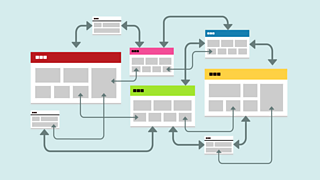
I hear this question quite a lot. User Experience Architecture deals with the more abstract parts of UX Design so it's sometimes harder for people to understand what we do. Over the next few months the UXA team will be sharing our work and ideas to give you a taste of what we do. But I wanted to give a quick introduction to the discipline.
We're information architects
At the heart of our practice is Information Architecture (IA).
As IAs we're focused on how the information environments that we build, live and work in can be more meaningful and usable. Information is everywhere, in every website, app and environment we inhabit. As we move around the world we make sense of it using the signals we perceive. We use signs and the properties of the environment to find our way and navigate. We match patterns and decode the properties of objects to understand how we can use them. IAs support this kind of sense and meaning making across physical and digital environments.
As a type of architect we're interested in the structures that support people as they navigate and use things. We think about the parts of things and how we can arrange those parts to be more understandable. It could be the parts of a workflow that journalists navigate to create an article. Or the parts of the news or sport websites. Or even how all the parts of ±«Óãtv online come together.
Complex systems are really lots of interconnected parts. We define, describe and arrange parts to create architecture with four main benefits:
- Coherence - Does it make sense and is it consistent
- Connections - Do the connections enable and enhance experiences
- Efficiency - Does it reduce effort, cost or both?
- Resilience - Does it work reliably and across contexts and at scale
Everyone makes Information Architecture
Every environment and design contains information architecture. As the IAs in UX&D we try to make sure that we're always making intentional Information Architecture. This means our designs fit their context and the contexts and systems that surround them. There are lots of connected systems and experiences at the ±«Óãtv so we balance coherence, connection, efficiency and resilience to optimise them for staff and audiences.
Lots of our work is invisible. It sometimes isn't even focused on the websites and apps that our audiences see and use. We feed into the design process as much as the finished product.
Making sense
All design relies on our senses. But it often relies on us making sense of statements and ideas for which it's impossible to share 'sense' data. We're creating something new, so often the shared language doesn't exist yet. Without architecture, design projects can get stuck in endless 'non-sense' discussions because the sense data and language doesn't exist. We fill that gap - that's what User Experience Architecture is - the structures and intentionally constructed contexts that make it easier to make sense of the world.
Over the next few months we'll be sharing more about how we do that, starting with Jo Chambers on how we using map-making to describe relationships.






